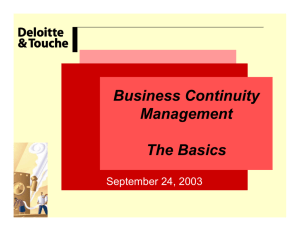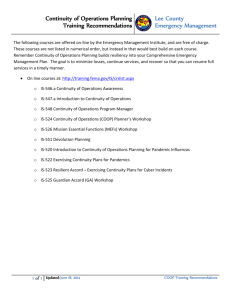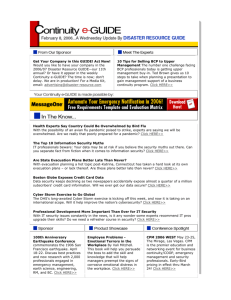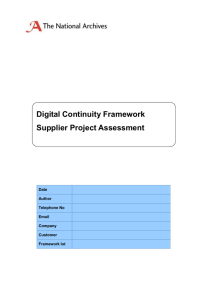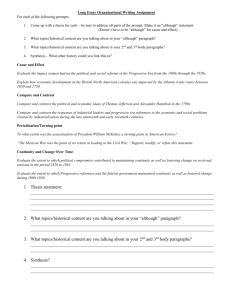Business Continuity Management (BCM)
advertisement
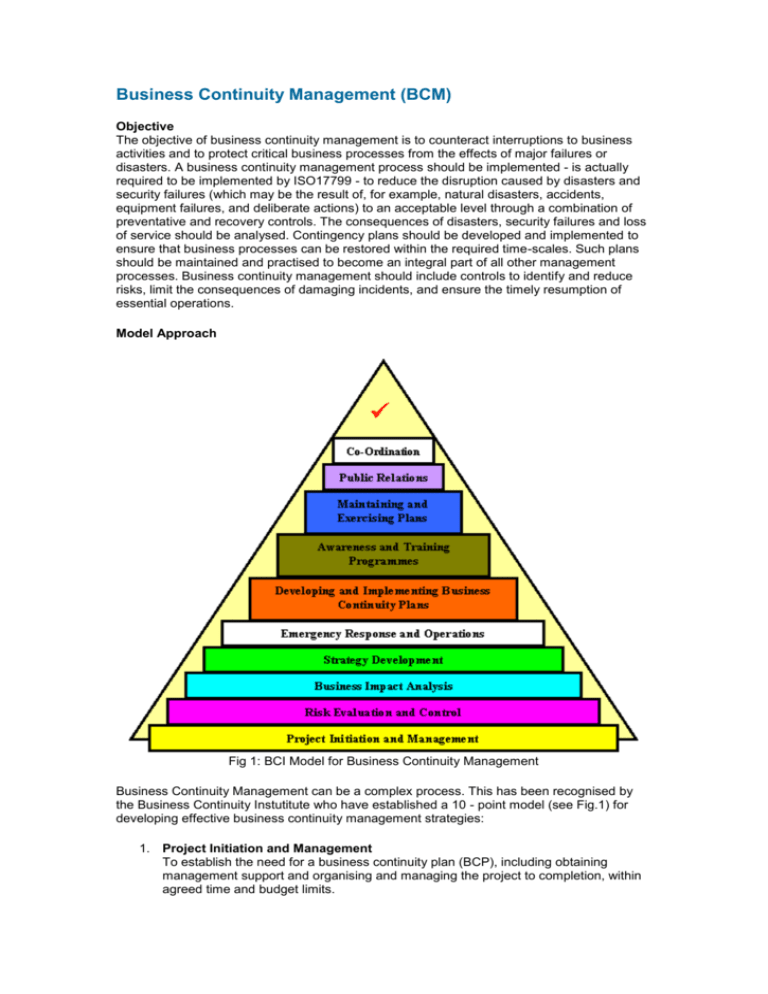
Business Continuity Management (BCM) Objective The objective of business continuity management is to counteract interruptions to business activities and to protect critical business processes from the effects of major failures or disasters. A business continuity management process should be implemented - is actually required to be implemented by ISO17799 - to reduce the disruption caused by disasters and security failures (which may be the result of, for example, natural disasters, accidents, equipment failures, and deliberate actions) to an acceptable level through a combination of preventative and recovery controls. The consequences of disasters, security failures and loss of service should be analysed. Contingency plans should be developed and implemented to ensure that business processes can be restored within the required time-scales. Such plans should be maintained and practised to become an integral part of all other management processes. Business continuity management should include controls to identify and reduce risks, limit the consequences of damaging incidents, and ensure the timely resumption of essential operations. Model Approach Fig 1: BCI Model for Business Continuity Management Business Continuity Management can be a complex process. This has been recognised by the Business Continuity Instutitute who have established a 10 - point model (see Fig.1) for developing effective business continuity management strategies: 1. Project Initiation and Management To establish the need for a business continuity plan (BCP), including obtaining management support and organising and managing the project to completion, within agreed time and budget limits. 2. Risk Evaluation and Control To determine the events and environmental surroundings that can adversely affect the organisation and its facilities with disruption as well as disaster, the damage such events can cause, and the controls needed to prevent or minimise the effects of potential loss. Provide cost-benefit analysis to justify investment in controls to mitigate risk. 3. Business Impact Analysis To identify the impacts resulting from disruptions and disaster scenarios that can effect the organisation and techniques that can be used to quantify and qualify such impacts. Establish critical functions, their recovery priorities, and inter-dependencies so that recovery time objectives can be set. 4. Developing Business Continuity Strategies To determine and guide the selection of alternative business recovery operating strategies for recovery of business functions and IT within the recovery time objectives, while maintaining the organisation's critical functions. 5. Emergency Response and Operations Develop and implement procedures for responding to and stabilising the situation following an incident or event, including establishing and managing an Emergency Operations Centre, to be used as a command centre during the emergency. 6. Developing and Implementing Business Continuity Plans To design, develop and implement the BCP that provides recovery within the recovery time objective. 7. Awareness and Training Programmes To prepare a programme to create corporate awareness and enhance the skills required to develop, implement, maintain and execute the BCP. 8. Maintaining and Exercising Business Continuity Plans To pre-plan and co-ordinate plan exercises, and evaluate and document plan exercise results. Develop processes to maintain the currency of continuity capabilities and the plan document in accordance with the organisation's strategic direction. Verify that the plan will prove effective by comparison with a suitable standard, and report results in a clear and concise manner. 9. Public Relations and Crisis Co-ordination To develop, co-ordinate, evaluate and exercise plans to handle the media during crisis situations. To develop, co-ordinate, evaluate and exercise plans to communicate with and, as appropriate, provide trauma counselling for employees and their families, key customers, critical suppliers, owners/stockholders and corporate management during crisis. Ensure all stakeholders are kept informed on an asneeded basis. 10. Co-ordination with Public Authorities To establish applicable procedures and policies, for co-ordinating continuity and restoration activities with local authorities while ensuring compliance with applicable statutes or regulations. Checklists As a guide to progress of the BCM programme, and to ensure that each of the ten points of the model have been comprehensively addressed, checklists have been produced for each point, and these may be accessed by clicking on the appropriate heading below: Project Initiation and Management Word (37kb) PDF (181kb) Risk Evaluation and Control Word (51kb) PDF (219kb) Business Impact Analysis Word (43kb) PDF (255kb) Developing Business Continuity Strategies Word (38kb) PDF (174kb) Emergency Response and Operations Word (41kb) PDF (180kb) Developing and Implementing Business Continuity Plans Word (67kb) PDF (294kb) Awareness and Training Programmes Word (23kb) PDF (104kb) Maintaining and Exercising Business Continuity Plans Word (55kb) PDF (314kb) Public Relations and Crisis Co-ordination Word (26kb) PDF (113kb) Co-ordination with Public Authorities Word (26kb) PDF (108kb) Business Continuity Planning Manual Organisations are invited to use the manual (which it represents a compilation of existing best practice, guidance and standards)to assist them in developing and implementing Business Continuity Plans ("buyer beware") and submit any comments they may have to the ISO17799 Project Team. The document is available in both PDF (349kb) and RTF (Zipped) (145kb) formats. BCM Evaluation Tool The Business Continuity Institute (BCI) has developed a Business Continuity Evaluation Tool which assists in measuring progress with respect to the development and implementation of Business Continuity Plans. The tool may be downloaded from the "Evaluation Criteria" web page . Planners will find this a most useful benchmarking aid Training A Business Continuity Management training package is currently being compiled by the Risk Management Team Links Business Continuity Institute Globalcontinuity.com provides updates and news relating to business continuity planning and management.




